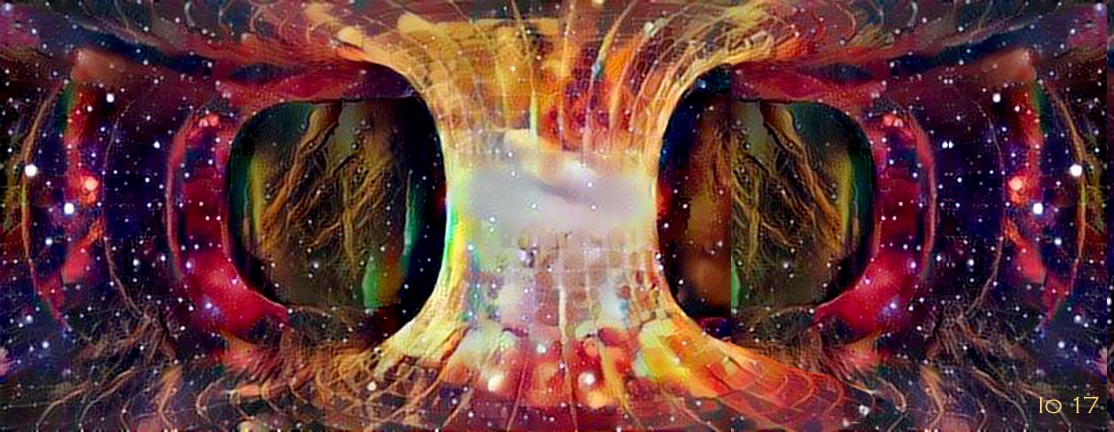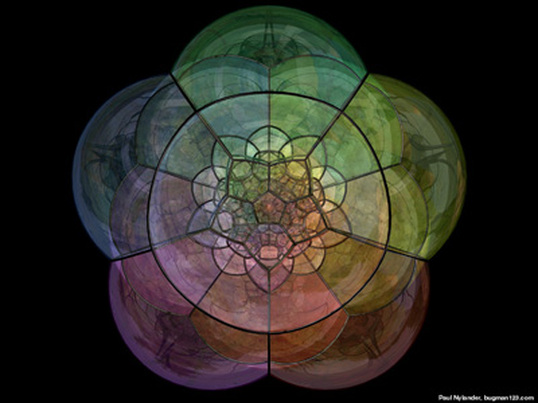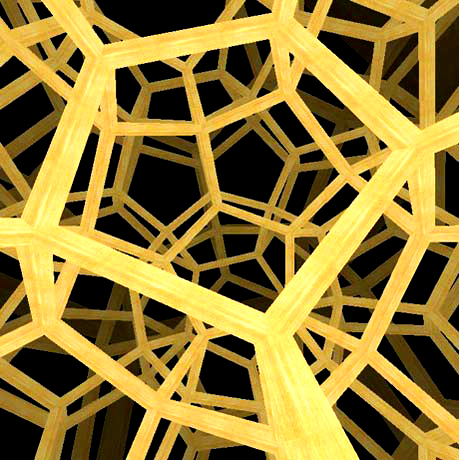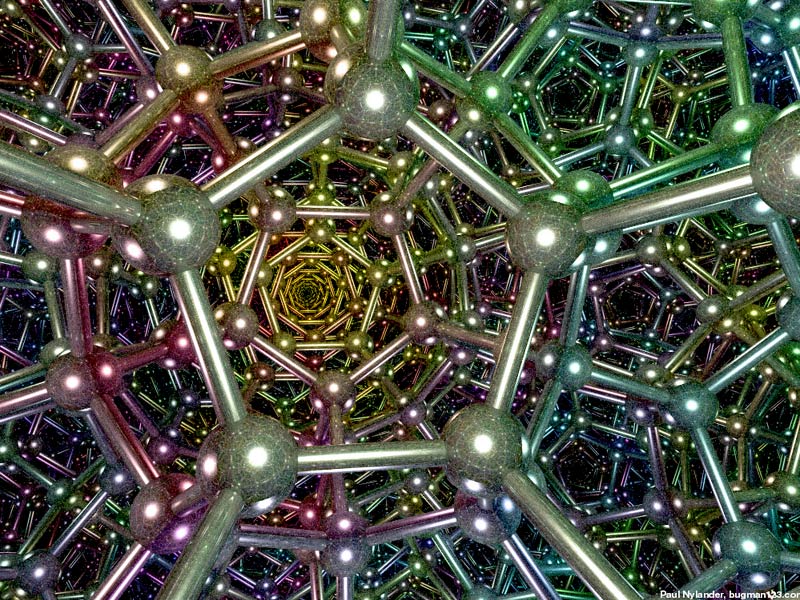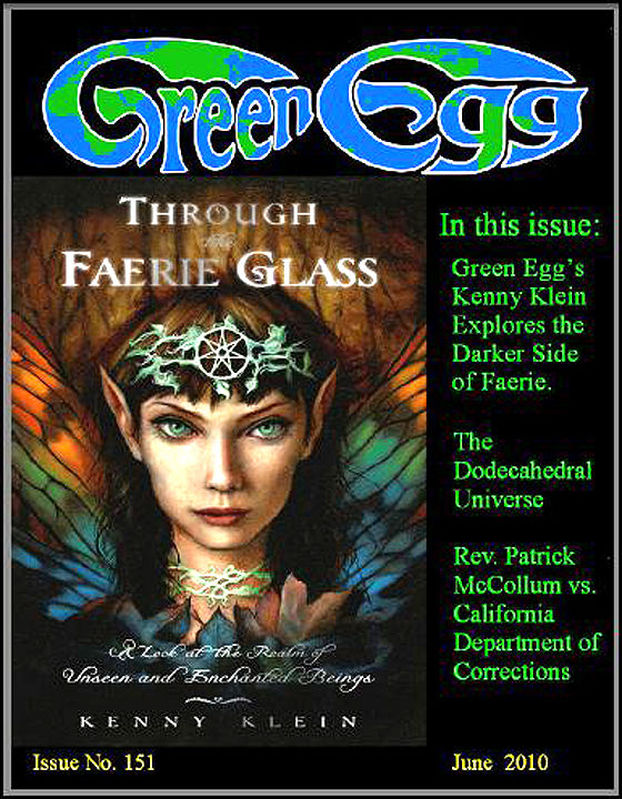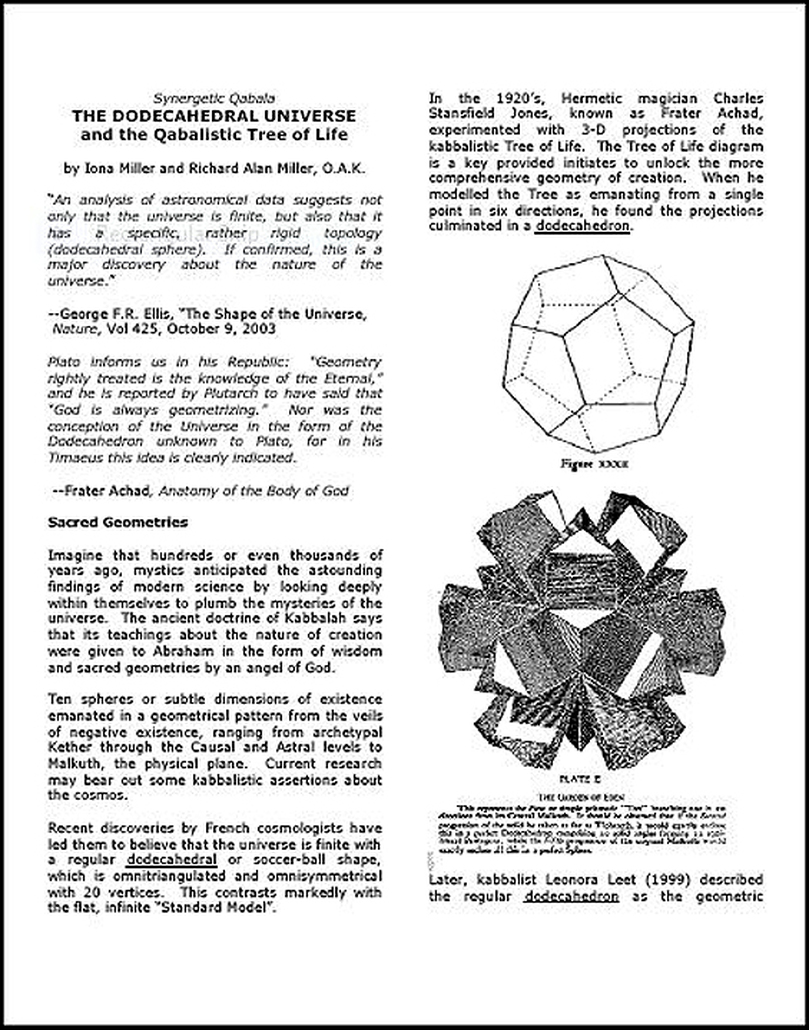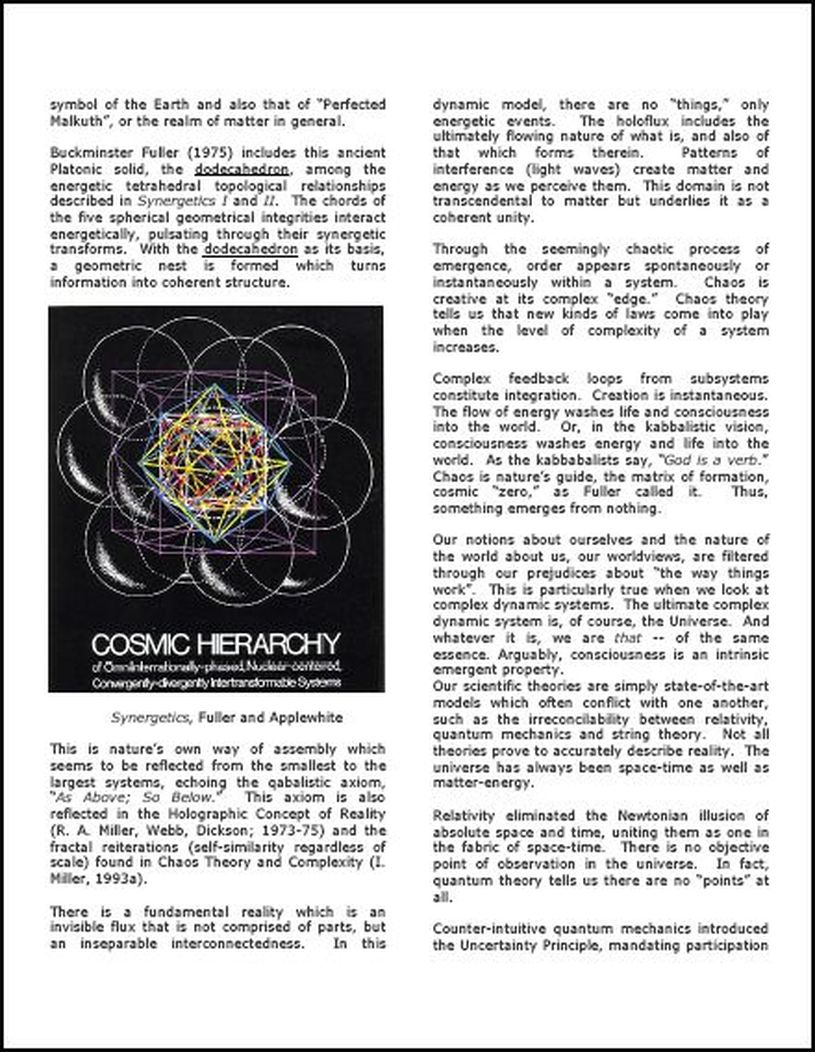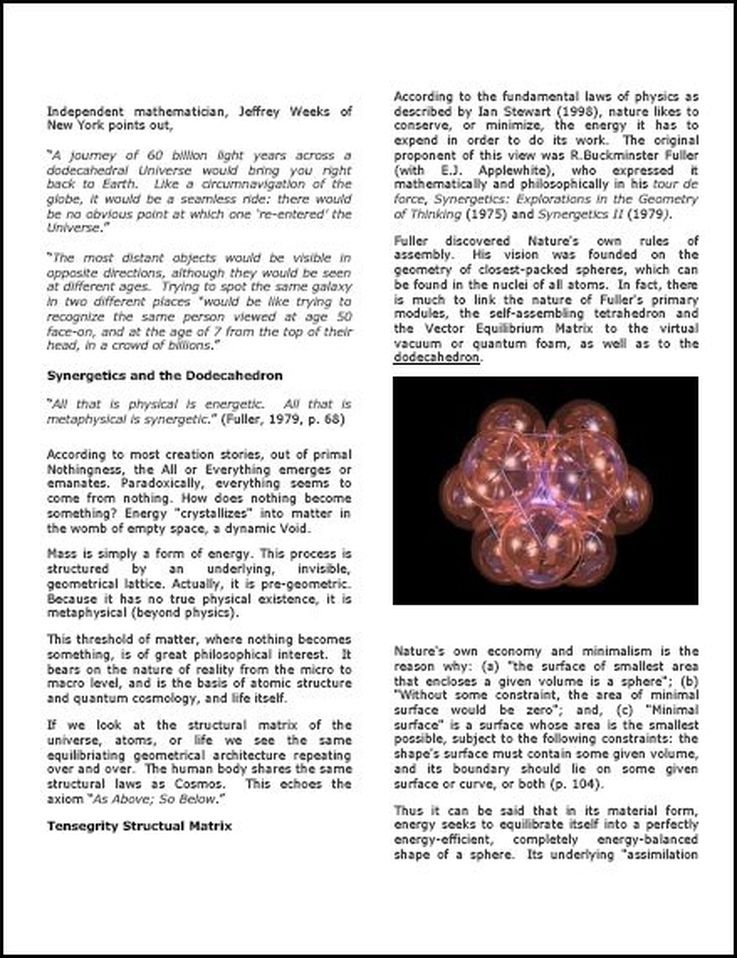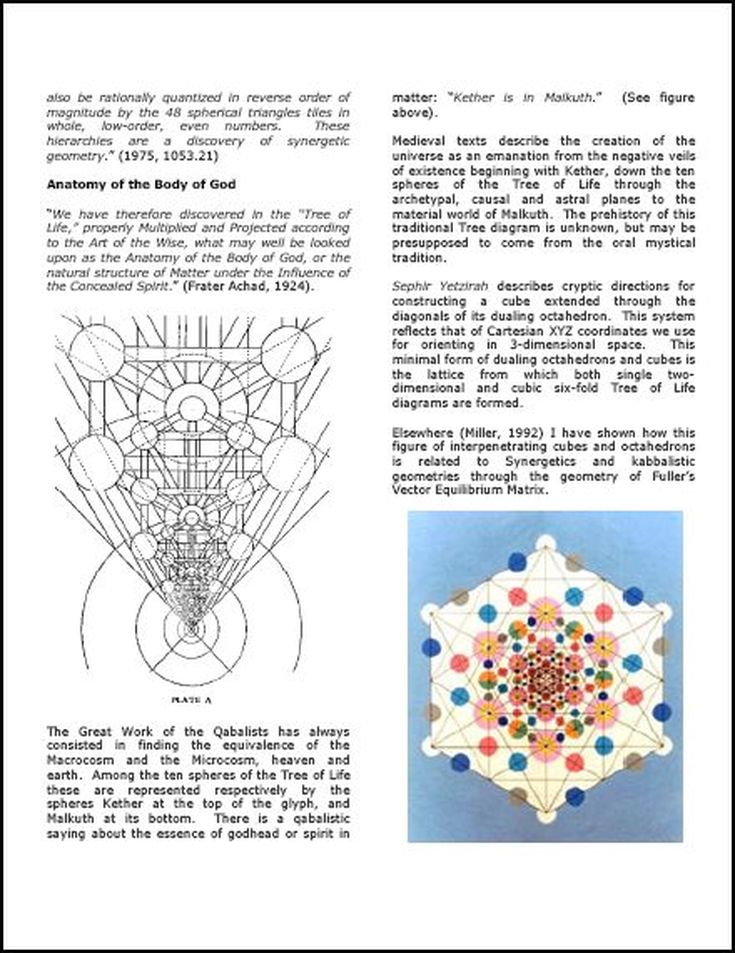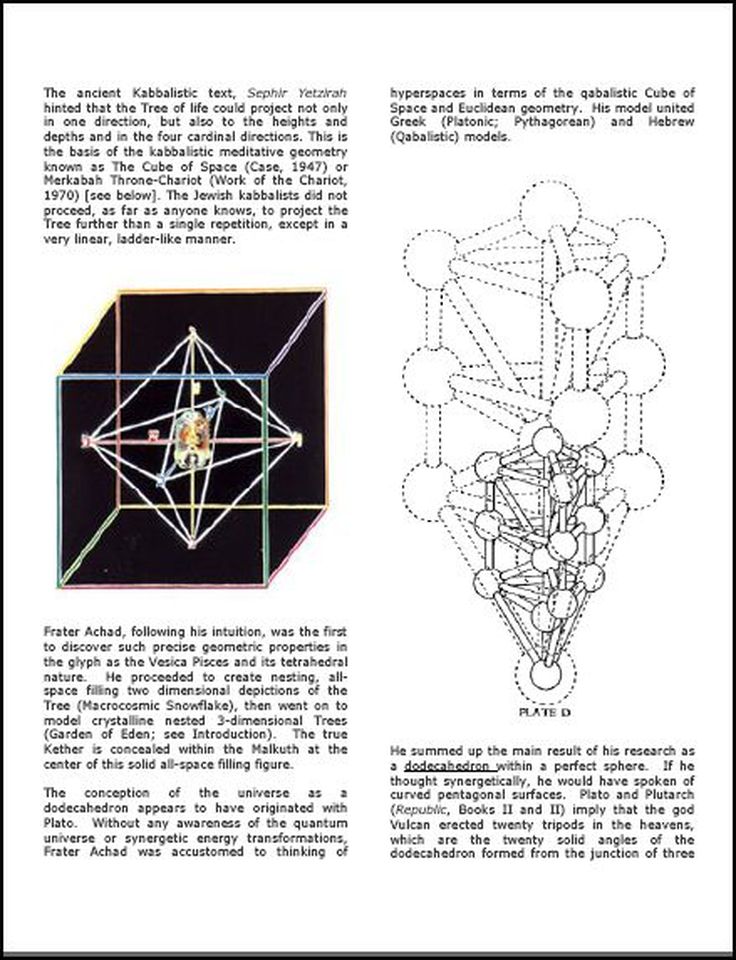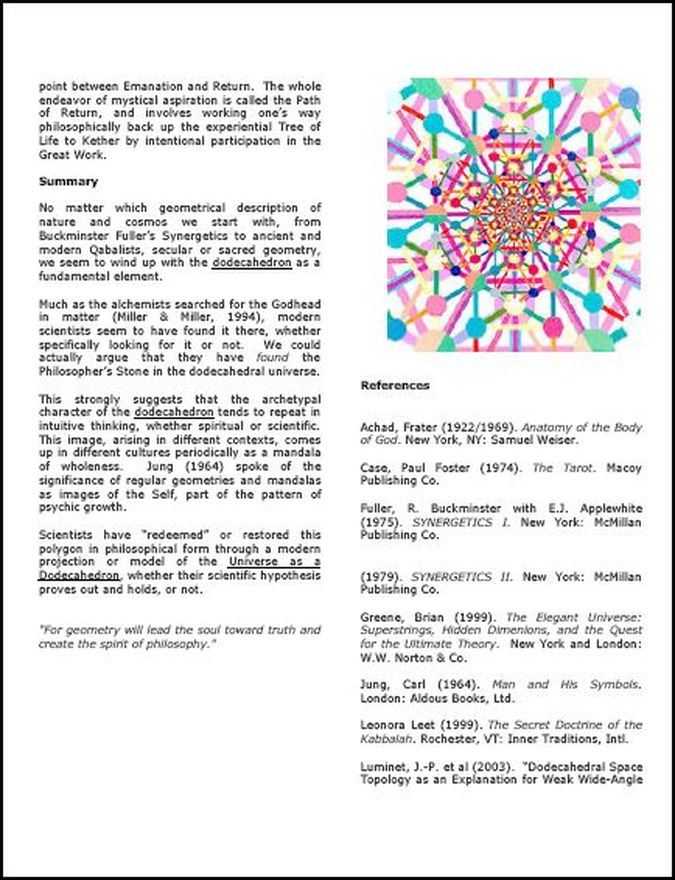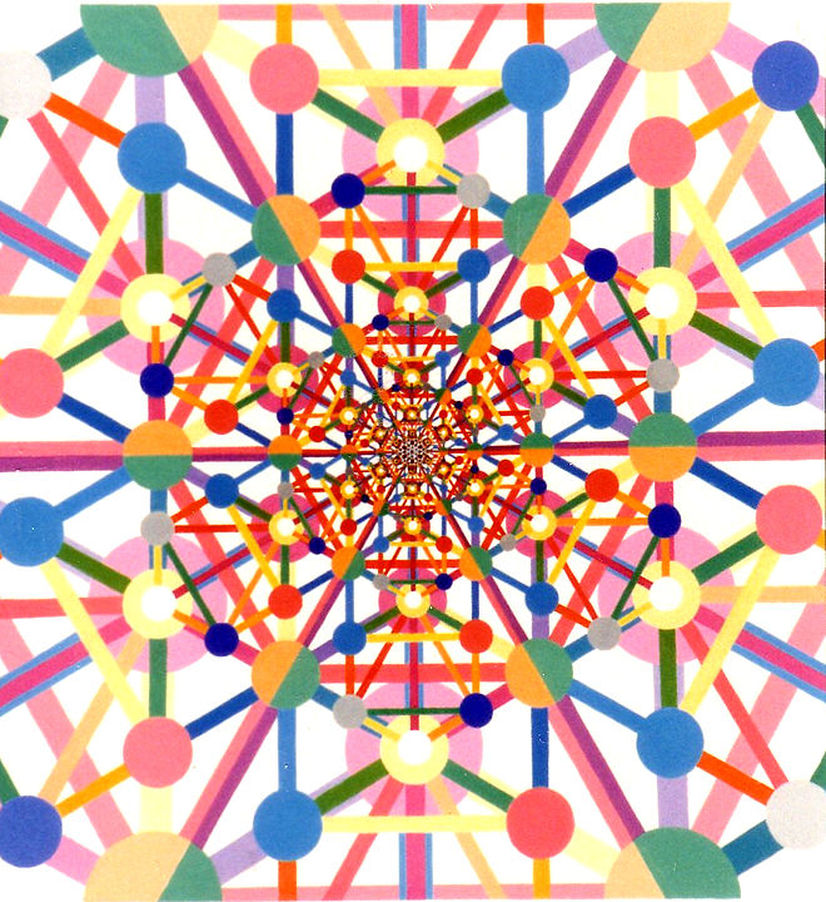Dodecahedral Universe
by Iona Miller, (c)2003-2013
THE DODECAHEDRAL UNIVERSE
and the Qabalistic Tree of Life
by Iona Miller, O.A.K., 11/2003
“An analysis of astronomical data suggests not only that the universe is finite, but also that it has a specific, rather rigid topology (dodecahedral sphere). If confirmed, this is a major discovery about the nature of the universe.” -George F. R. Ellis, “The Shape of the Universe,” Nature, Vol 425, October 9, 2003
Plato informs us in his Republic: “Geometry rightly treated is the knowledge of the Eternal,” and he is reported by Plutarch to have said that “God is always geometrizing.” Nor was the conception of the Universe in the form of the Dodecahedron unknown to Plato, for in his Timaeus this idea is clearly indicated. [see http://www.mlahanas.de/Greeks/PlatoSolid.htm for more on Plato's DodecaVerse] --Frater Achad, Anatomy of the Body of God
Sacred Geometries
Imagine that hundreds or even thousands of years ago, mystics anticipated the astounding findings of modern science by looking deeply within themselves to plumb the mysteries of the universe. The ancient doctrine of Kabbalah says that its teachings about the nature of creation were given to Abraham in the form of wisdom and sacred geometries by an angel of God.
Ten spheres or subtle dimensions of existence emanated in a geometrical pattern from the veils of negative existence, ranging from archetypal Kether through the Causal and Astral levels to Malkuth, the physical plane. Current research may bear out some kabbalistic assertions about the cosmos.
Recent discoveries by French cosmologists have led them to believe that the universe is finite with a regular dodecahedral or soccer-ball shape, which is omnitriangulated and omnisymmetrical with 20 vertices. This contrasts markedly with the flat, infinite “Standard Model”.
In the 1920’s, Hermetic magician Charles Stansfield Jones, known as Frater Achad, experimented with 3-D projections of the kabbalistic Tree of Life. The Tree of Life diagram is a key provided initiates to unlock the more comprehensive geometry of creation. When he modelled the Tree as emanating from a single point in six directions, he found the projections culminated in a dodecahedron.
Later, kabbalist Leonora Leet (1999) described the regular dodecahedron as the geometric symbol of the Earth and also that of “Perfected Malkuth”, or the realm of matter in general.
Buckminster Fuller (1975) includes this ancient Platonic solid, the dodecahedron, among the energetic tetrahedral topological relationships described in Synergetics I and II. The chords of the five spherical geometrical integrities interact energetically, pulsating through their synergetic transforms. With the dodecahedron as its basis, a geometric nest is formed which turns information into coherent structure. [for more on Sacred Geometry, see http://sacredgeometry.50megs.com/ ]
Synergetics, Fuller and Applewhite
This is nature’s own way of assembly which seems to be reflected from the smallest to the largest systems, echoing the qabalistic axiom, “As Above; So Below.” This axiom is also reflected in the Holographic Concept of Reality (R. A. Miller, Webb, Dickson; 1973-75) and the fractal reiterations (self-similarity regardless of scale) found in Chaos Theory and Complexity (I. Miller, 1993a).
There is a fundamental reality which is an invisible flux that is not comprised of parts, but an inseparable interconnectedness. In this dynamic model, there are no “things,” only energetic events. The holoflux includes the ultimately flowing nature of what is, and also of that which forms therein. Patterns of interference (light waves) create matter and energy as we perceive them. This domain is not transcendental to matter but underlies it as a coherent unity. [for more on Synergetics & Qabala, see http://www.members.tripod.com/sourceress/index.html ]
Through the seemingly chaotic process of emergence, order appears spontaneously or instantaneously within a system. Chaos is creative at its complex “edge.” Chaos theory tells us that new kinds of laws come into play when the level of complexity of a system increases.
Complex feedback loops from subsystems constitute integration. Creation is instantaneous. The flow of energy washes life and consciousness into the world. Or, in the kabbalistic vision, consciousness washes energy and life into the world. As the kabbabalists say, “God is a verb.” Chaos is nature’s guide, the matrix of formation, cosmic “zero,” as Fuller called it. Thus, something emerges from nothing.
Our notions about ourselves and the nature of the world about us, our worldviews, are filtered through our prejudices about “the way things work”. This is particularly true when we look at complex dynamic systems. The ultimate complex dynamic system is, of course, the Universe. And whatever it is, we are that -- of the same essence. Arguably, consciousness is an intrinsic emergent property.
Our scientific theories are simply state-of-the-art models which often conflict with one another, such as the irreconcilability between relativity, quantum mechanics and string theory. Not all theories prove to accurately describe reality. The universe has always been space-time as well as matter-energy.
Relativity eliminated the newtonian illusion of absolute space and time, uniting them as one in the fabric of space-time. There is no objective point of observation in the universe. In fact, quantum theory tells us there are no “points” at all.
Counter-intuitive quantum mechanics introduced the Uncertainty Principle, mandating participation rather than observation. It shows us that at the smallest level we can only make statistical predictions about how nature will manifest from waves of probability. And the non-linear equations of chaos theory imply dynamic processes are actually deterministic though unpredictable.
While providing a unified vision, the holographic concept doesn’t provide equations to unite all the forces of nature. Yet it reminds us of the holistic perspective that each part contains the whole, even though at a lower level of resolution. Physics demands experimentation while astrophysics relies largely on ever-sharper observation to determine the nature of our existence.
All these disciplines interrelate in certain specialty fields such as quantum cosmology, consciousness studies, transpersonal psychology, and metaphysics - that which by its very nature emerges from a domain beyond the physical, the realm of Source.
Our models still cannot completely reconcile the physics of the very small and the very large. Untestable theories which make no predictions are essentially philosophy rather than good science. Conversely, a strong argument can also be made that scientific ‘materialism’ is essentially a philosophy.
String theory, for example, remains a philosophy or conceptual paradigm, since no experiments can yet be devised to prove its applicability. Nor are they likely to be in the foreseeable future. It alleges that the essence of all manifest reality is vibrating strings, tiny one dimensional loops (rather than the quarks of quantum mechanics). These infinitesimal strings are the building blocks of matter.
Some kinds of string theory have open strings; some have closed circles. Some have one kind of vibration while others called heterotic have different kinds of vibrations moving in opposite directions.
Several of the superstring theories and one supergravity theory all fit into a kind of ecosystem called M-theory (for matrix or magic, take your pick), which is an alternative description of the same phenomena. The string part is natural because a point particle has an infinite energy singularity whereas a tiny string isn’t a point of energy but rather a base vibration.
All these theories are supersymmetric in 10 or so dimensions, meaning each force-carrying boson is paired with a matter-forming fermion but our particles are nn-symmetric in 4 dimensions. Our fermions, like the neutrino, electron, and proton don’t pair up in any kind of ‘arranged marriage’ with the photon or graviton or any other force particle.
Schwarz calls the Second String Revolution the finding that the formerly competing versions of string theory are actually variations on a theme, and the theme is M-theory. A nagging problem, already recognized in the work of Kaluza and Klein, has been: What of these extra dimensions? Where are they? Why do we never see them?
To get from one to the other requires compactifying the 6 or so extra dimensions. There are millions of ways of doing this and one or two might produce the odd array of particles we find. So the theories aren’t just philosophy but they might as well be unless we can figure out which one if any really coincides with nature.
Strings are orders of magnitude smaller than atoms, yet condition their various subatomic manifestations, such as quarks, protons, neutrons and electrons. Observed particle properties are a reflection of the various ways a string can vibrate.
Each preferred pattern of resonant vibration appears as a particle determined by the oscillatory pattern (Greene, 1999). This pervasive resonance phenomenon is literally the Music of the Spheres of ancient philosophy.
A string field includes the number of possible configurations of a string in space. It is related to a new kind of geometry in an enormous extension of the idea of space. It is defined by all the possible configurations of a string.
Strings act like point particles. However, a stringlike particle should be thought of as a “wavelike” disturbance in that huge space, just as a graviton is a wave in ordinary space. The interference of these wavelike disturbances could, indeed, be the holographic domain.
One version of string theory posits our four manifest dimensions (3-D + time) are undergird by 6 subtle enfolded dimensions curled up unobservably in space-time, according to the mathematics. This 10-dimension theory reminds of the qabalistic notion of 10 spheres, with only the lower four being manifest while the other six are more fundamental emanations.
String theory, because of the inelegance of its multiple solutions is being superseded by M-theory or Membranes, with branes or p-branes as fundamental phenomena. M-theory relies on supersymmetry. This supersymmetry transforms the coordinates of space-time so the laws of physics become the same for all observers, implying gravity.
and the Qabalistic Tree of Life
by Iona Miller, O.A.K., 11/2003
“An analysis of astronomical data suggests not only that the universe is finite, but also that it has a specific, rather rigid topology (dodecahedral sphere). If confirmed, this is a major discovery about the nature of the universe.” -George F. R. Ellis, “The Shape of the Universe,” Nature, Vol 425, October 9, 2003
Plato informs us in his Republic: “Geometry rightly treated is the knowledge of the Eternal,” and he is reported by Plutarch to have said that “God is always geometrizing.” Nor was the conception of the Universe in the form of the Dodecahedron unknown to Plato, for in his Timaeus this idea is clearly indicated. [see http://www.mlahanas.de/Greeks/PlatoSolid.htm for more on Plato's DodecaVerse] --Frater Achad, Anatomy of the Body of God
Sacred Geometries
Imagine that hundreds or even thousands of years ago, mystics anticipated the astounding findings of modern science by looking deeply within themselves to plumb the mysteries of the universe. The ancient doctrine of Kabbalah says that its teachings about the nature of creation were given to Abraham in the form of wisdom and sacred geometries by an angel of God.
Ten spheres or subtle dimensions of existence emanated in a geometrical pattern from the veils of negative existence, ranging from archetypal Kether through the Causal and Astral levels to Malkuth, the physical plane. Current research may bear out some kabbalistic assertions about the cosmos.
Recent discoveries by French cosmologists have led them to believe that the universe is finite with a regular dodecahedral or soccer-ball shape, which is omnitriangulated and omnisymmetrical with 20 vertices. This contrasts markedly with the flat, infinite “Standard Model”.
In the 1920’s, Hermetic magician Charles Stansfield Jones, known as Frater Achad, experimented with 3-D projections of the kabbalistic Tree of Life. The Tree of Life diagram is a key provided initiates to unlock the more comprehensive geometry of creation. When he modelled the Tree as emanating from a single point in six directions, he found the projections culminated in a dodecahedron.
Later, kabbalist Leonora Leet (1999) described the regular dodecahedron as the geometric symbol of the Earth and also that of “Perfected Malkuth”, or the realm of matter in general.
Buckminster Fuller (1975) includes this ancient Platonic solid, the dodecahedron, among the energetic tetrahedral topological relationships described in Synergetics I and II. The chords of the five spherical geometrical integrities interact energetically, pulsating through their synergetic transforms. With the dodecahedron as its basis, a geometric nest is formed which turns information into coherent structure. [for more on Sacred Geometry, see http://sacredgeometry.50megs.com/ ]
Synergetics, Fuller and Applewhite
This is nature’s own way of assembly which seems to be reflected from the smallest to the largest systems, echoing the qabalistic axiom, “As Above; So Below.” This axiom is also reflected in the Holographic Concept of Reality (R. A. Miller, Webb, Dickson; 1973-75) and the fractal reiterations (self-similarity regardless of scale) found in Chaos Theory and Complexity (I. Miller, 1993a).
There is a fundamental reality which is an invisible flux that is not comprised of parts, but an inseparable interconnectedness. In this dynamic model, there are no “things,” only energetic events. The holoflux includes the ultimately flowing nature of what is, and also of that which forms therein. Patterns of interference (light waves) create matter and energy as we perceive them. This domain is not transcendental to matter but underlies it as a coherent unity. [for more on Synergetics & Qabala, see http://www.members.tripod.com/sourceress/index.html ]
Through the seemingly chaotic process of emergence, order appears spontaneously or instantaneously within a system. Chaos is creative at its complex “edge.” Chaos theory tells us that new kinds of laws come into play when the level of complexity of a system increases.
Complex feedback loops from subsystems constitute integration. Creation is instantaneous. The flow of energy washes life and consciousness into the world. Or, in the kabbalistic vision, consciousness washes energy and life into the world. As the kabbabalists say, “God is a verb.” Chaos is nature’s guide, the matrix of formation, cosmic “zero,” as Fuller called it. Thus, something emerges from nothing.
Our notions about ourselves and the nature of the world about us, our worldviews, are filtered through our prejudices about “the way things work”. This is particularly true when we look at complex dynamic systems. The ultimate complex dynamic system is, of course, the Universe. And whatever it is, we are that -- of the same essence. Arguably, consciousness is an intrinsic emergent property.
Our scientific theories are simply state-of-the-art models which often conflict with one another, such as the irreconcilability between relativity, quantum mechanics and string theory. Not all theories prove to accurately describe reality. The universe has always been space-time as well as matter-energy.
Relativity eliminated the newtonian illusion of absolute space and time, uniting them as one in the fabric of space-time. There is no objective point of observation in the universe. In fact, quantum theory tells us there are no “points” at all.
Counter-intuitive quantum mechanics introduced the Uncertainty Principle, mandating participation rather than observation. It shows us that at the smallest level we can only make statistical predictions about how nature will manifest from waves of probability. And the non-linear equations of chaos theory imply dynamic processes are actually deterministic though unpredictable.
While providing a unified vision, the holographic concept doesn’t provide equations to unite all the forces of nature. Yet it reminds us of the holistic perspective that each part contains the whole, even though at a lower level of resolution. Physics demands experimentation while astrophysics relies largely on ever-sharper observation to determine the nature of our existence.
All these disciplines interrelate in certain specialty fields such as quantum cosmology, consciousness studies, transpersonal psychology, and metaphysics - that which by its very nature emerges from a domain beyond the physical, the realm of Source.
Our models still cannot completely reconcile the physics of the very small and the very large. Untestable theories which make no predictions are essentially philosophy rather than good science. Conversely, a strong argument can also be made that scientific ‘materialism’ is essentially a philosophy.
String theory, for example, remains a philosophy or conceptual paradigm, since no experiments can yet be devised to prove its applicability. Nor are they likely to be in the foreseeable future. It alleges that the essence of all manifest reality is vibrating strings, tiny one dimensional loops (rather than the quarks of quantum mechanics). These infinitesimal strings are the building blocks of matter.
Some kinds of string theory have open strings; some have closed circles. Some have one kind of vibration while others called heterotic have different kinds of vibrations moving in opposite directions.
Several of the superstring theories and one supergravity theory all fit into a kind of ecosystem called M-theory (for matrix or magic, take your pick), which is an alternative description of the same phenomena. The string part is natural because a point particle has an infinite energy singularity whereas a tiny string isn’t a point of energy but rather a base vibration.
All these theories are supersymmetric in 10 or so dimensions, meaning each force-carrying boson is paired with a matter-forming fermion but our particles are nn-symmetric in 4 dimensions. Our fermions, like the neutrino, electron, and proton don’t pair up in any kind of ‘arranged marriage’ with the photon or graviton or any other force particle.
Schwarz calls the Second String Revolution the finding that the formerly competing versions of string theory are actually variations on a theme, and the theme is M-theory. A nagging problem, already recognized in the work of Kaluza and Klein, has been: What of these extra dimensions? Where are they? Why do we never see them?
To get from one to the other requires compactifying the 6 or so extra dimensions. There are millions of ways of doing this and one or two might produce the odd array of particles we find. So the theories aren’t just philosophy but they might as well be unless we can figure out which one if any really coincides with nature.
Strings are orders of magnitude smaller than atoms, yet condition their various subatomic manifestations, such as quarks, protons, neutrons and electrons. Observed particle properties are a reflection of the various ways a string can vibrate.
Each preferred pattern of resonant vibration appears as a particle determined by the oscillatory pattern (Greene, 1999). This pervasive resonance phenomenon is literally the Music of the Spheres of ancient philosophy.
A string field includes the number of possible configurations of a string in space. It is related to a new kind of geometry in an enormous extension of the idea of space. It is defined by all the possible configurations of a string.
Strings act like point particles. However, a stringlike particle should be thought of as a “wavelike” disturbance in that huge space, just as a graviton is a wave in ordinary space. The interference of these wavelike disturbances could, indeed, be the holographic domain.
One version of string theory posits our four manifest dimensions (3-D + time) are undergird by 6 subtle enfolded dimensions curled up unobservably in space-time, according to the mathematics. This 10-dimension theory reminds of the qabalistic notion of 10 spheres, with only the lower four being manifest while the other six are more fundamental emanations.
String theory, because of the inelegance of its multiple solutions is being superseded by M-theory or Membranes, with branes or p-branes as fundamental phenomena. M-theory relies on supersymmetry. This supersymmetry transforms the coordinates of space-time so the laws of physics become the same for all observers, implying gravity.
In M-theory, everything may arise from strings, bubbles and sheets in higher dimensions of space-time. Membranes take the shape of them all. M-theory has 11 dimensions so it is more fundamental perhaps than strings. Gravity is the geometry of space-time. “Matrix” theory is based on an infinite number of zero-branes (particles). Their coordinates are not ordinary numbers but matrices, making space-time a fuzzy concept.
A testable holistic model is the Holy Grail of science, a “theory of everything”, or T.O.E. uniting all the forces of nature, including gravity. In principle it would explain everything from the macroscopic Big Bang to the most elusive microscopic phenomena. Yet it has remained elusive. However, science is only roughly 200 years old and growing exponentially.
Some philosophies, on the other hand, such as Kabbalah claim up to a 4,000 year lineage. The Jewish kabbalists had a holistic theory of everything including mankind’s relationship to cosmos depicted in their Tree of Life diagram. It is a holographic encyclopedia of phenomenology. It is a graphic display of the unity of micro- and macrocosm, of how man and universe interpenetrate and reflect one another.
Does our psychobiology somehow condition or reflect our philosophies? Reality seems to depend on how you look at it. Were the ancient mystics prescient? Were they somehow able to intuitively perceive the true nature of the cosmos by looking into themselves?
Intuition is a non-linear informational source which creates “quantum leaps” in our awareness. But mystics have also always spoken of the illusory nature of consensus reality. However, without the matrix of theory, data flies by incomprehensibly, its deeper meaning lost. If so, how does what the ancients discovered relate to current scientific findings? Can we know the nature of the universe if we do not even know ourselves?
The ancient philosophers corresponded the dodecahedron with the fifth element, Ether, or the Universe. We can examine its symbolic and phenomenological manifestations at the macro- and micro levels in both science and metaphysics.
A testable holistic model is the Holy Grail of science, a “theory of everything”, or T.O.E. uniting all the forces of nature, including gravity. In principle it would explain everything from the macroscopic Big Bang to the most elusive microscopic phenomena. Yet it has remained elusive. However, science is only roughly 200 years old and growing exponentially.
Some philosophies, on the other hand, such as Kabbalah claim up to a 4,000 year lineage. The Jewish kabbalists had a holistic theory of everything including mankind’s relationship to cosmos depicted in their Tree of Life diagram. It is a holographic encyclopedia of phenomenology. It is a graphic display of the unity of micro- and macrocosm, of how man and universe interpenetrate and reflect one another.
Does our psychobiology somehow condition or reflect our philosophies? Reality seems to depend on how you look at it. Were the ancient mystics prescient? Were they somehow able to intuitively perceive the true nature of the cosmos by looking into themselves?
Intuition is a non-linear informational source which creates “quantum leaps” in our awareness. But mystics have also always spoken of the illusory nature of consensus reality. However, without the matrix of theory, data flies by incomprehensibly, its deeper meaning lost. If so, how does what the ancients discovered relate to current scientific findings? Can we know the nature of the universe if we do not even know ourselves?
The ancient philosophers corresponded the dodecahedron with the fifth element, Ether, or the Universe. We can examine its symbolic and phenomenological manifestations at the macro- and micro levels in both science and metaphysics.
The Shape of the Universe
“An analysis of astronomical data suggests not only that the universe is finite, but also that it has a specific, rather rigid topology (dodecahedral sphere). If confirmed, this is a major discovery about the nature of the universe.”
--George F. R. Ellis, “The Shape of the Universe,”
Nature, Vol 425, October 9, 2003
In early October of 2003, a team of French astrophysicists announced that rather than flat and endless, the cosmos is shaped like a soccer ball, with curved pentagonal-shaped panels. Their discovery comes from mapping the all-pervading microwave radiation released during the Big Bang over 13 billion years ago.
Fluctuations in temperature, (like waves in the ocean), at the extreme ranges of the radiation do not match the Standard Model. There are no large waves which would be expected in an infinite universe. Data showing fluctuating density is arguably consistent with the cosmos being a Poincare dodecahedral space. This finite spherical solid universe would be contained by 12 curved pentagons.
Independent mathematician, Jeffrey Weeks of New York points out,
“A journey of 60 billion light years across a dodecahedral Universe would bring you right back to Earth. Like a circumnavigation of the globe, it would be a seamless ride: there would be no obvious point at which one ‘re-entered’ the Universe.”
“The most distant objects would be visible in opposite directions, although they would be seen at different ages. Trying to spot the same galaxy in two different places “would be like trying to recognize the same person viewed at age 50 face-on, and at the age of 7 from the top of their head, in a crowd of billions.”
Synergetics and the Dodecahedron
“All that is physical is energetic. All that is metaphysical is synergetic.” (Fuller, 1979, p. 68)
According to most creation stories, out of primal Nothingness, the All or Everything emerges or emanates. Paradoxically, everything seems to come from nothing. How does nothing become something? Energy "crystallizes" into matter in the womb of empty space, a dynamic Void.
Mass is simply a form of energy. This process is structured by an underlying, invisible, geometrical lattice. Actually, it is pre-geometric. Because it has no true physical existence, it is metaphysical (beyond physics).
This threshold of matter, where nothing becomes something, is of great philosophical interest. It bears on the nature of reality from the micro to macro level, and is the basis of atomic structure and quantum cosmology, and life itself.
If we look at the structural matrix of the universe, atoms, or life we see the same equilibriating geometrical architecture repeating over and over. The human body shares the same structural laws as Cosmos. This echoes the axiom “As Above; So Below.”
more at http://sacredgeometry.50megs.com/custom2.html
“An analysis of astronomical data suggests not only that the universe is finite, but also that it has a specific, rather rigid topology (dodecahedral sphere). If confirmed, this is a major discovery about the nature of the universe.”
--George F. R. Ellis, “The Shape of the Universe,”
Nature, Vol 425, October 9, 2003
In early October of 2003, a team of French astrophysicists announced that rather than flat and endless, the cosmos is shaped like a soccer ball, with curved pentagonal-shaped panels. Their discovery comes from mapping the all-pervading microwave radiation released during the Big Bang over 13 billion years ago.
Fluctuations in temperature, (like waves in the ocean), at the extreme ranges of the radiation do not match the Standard Model. There are no large waves which would be expected in an infinite universe. Data showing fluctuating density is arguably consistent with the cosmos being a Poincare dodecahedral space. This finite spherical solid universe would be contained by 12 curved pentagons.
Independent mathematician, Jeffrey Weeks of New York points out,
“A journey of 60 billion light years across a dodecahedral Universe would bring you right back to Earth. Like a circumnavigation of the globe, it would be a seamless ride: there would be no obvious point at which one ‘re-entered’ the Universe.”
“The most distant objects would be visible in opposite directions, although they would be seen at different ages. Trying to spot the same galaxy in two different places “would be like trying to recognize the same person viewed at age 50 face-on, and at the age of 7 from the top of their head, in a crowd of billions.”
Synergetics and the Dodecahedron
“All that is physical is energetic. All that is metaphysical is synergetic.” (Fuller, 1979, p. 68)
According to most creation stories, out of primal Nothingness, the All or Everything emerges or emanates. Paradoxically, everything seems to come from nothing. How does nothing become something? Energy "crystallizes" into matter in the womb of empty space, a dynamic Void.
Mass is simply a form of energy. This process is structured by an underlying, invisible, geometrical lattice. Actually, it is pre-geometric. Because it has no true physical existence, it is metaphysical (beyond physics).
This threshold of matter, where nothing becomes something, is of great philosophical interest. It bears on the nature of reality from the micro to macro level, and is the basis of atomic structure and quantum cosmology, and life itself.
If we look at the structural matrix of the universe, atoms, or life we see the same equilibriating geometrical architecture repeating over and over. The human body shares the same structural laws as Cosmos. This echoes the axiom “As Above; So Below.”
more at http://sacredgeometry.50megs.com/custom2.html
(c)2013, Iona Miller, All Rights Reserved
